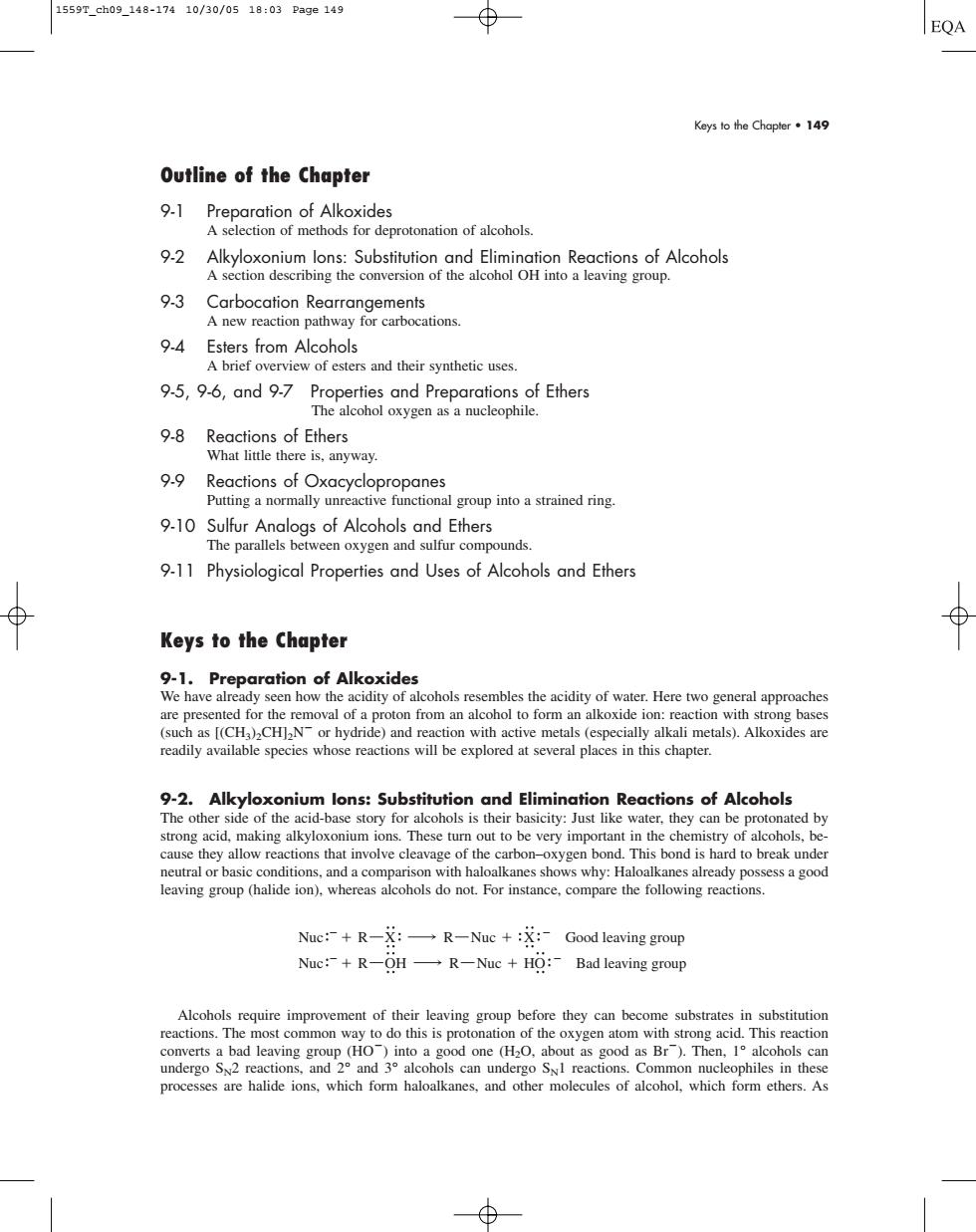正在加载图片...

1559T_ch09_148-17410/30/0518:03Pa9e149 ⊕ EQA Keys to the Chopler·149 Outline of the Chapter 9-1 Preparation of Alkoxides A selection of methods for deprotonation of alcohols. 92AhoanmbeistbsmieaadnoicnaecinetnodAcohob 93 Carbocation Rearrangements new reaction pathway for carbocation 9-4 Esters from Alcohols A brief overview of esters and their synthetic uses. 95,96,ond97heeomdeaiemictEhe 9-8 anyway 9-9 Reactions of Oxacyclopropanes Putting a normally unreactive functional group into a strained ring 9-10 Sulfur Analogs of Alcohols and Ethers The parallels between oxygen and sulfur compounds. 9-11 Physiological Properties and Uses of Alcohols and Ethers Keys to the Chapter Preparation of Alkoxides cohols rese Her ,gAas r hydride)and re m lons:Substitution and Elimingtion Reactions of Alcohols acid-base story for alcohols is their basicity:Just like water.they can be protonated by alcohols, neutral or basic conditions.and a comparison with haloalkanes shows why:Haloalkanes already possess a good leaving group (halide ion),whereas alcohols do not.For instance.compare the following reactions. Nuc:+R-R-Nuc+:Good leaving group Nuc:+R-OH-R-Nuc HO:Bad leaving group Alcohols require improvement of their leaving group before they can become substrates in substitution ad1leaconmon e oxygen atom w Br).Thg aci processes are halide ions,which form haloalkanes,and other molecules of alcohol,which form ethers.As Keys to the Chapter • 149 Outline of the Chapter 9-1 Preparation of Alkoxides A selection of methods for deprotonation of alcohols. 9-2 Alkyloxonium Ions: Substitution and Elimination Reactions of Alcohols A section describing the conversion of the alcohol OH into a leaving group. 9-3 Carbocation Rearrangements A new reaction pathway for carbocations. 9-4 Esters from Alcohols A brief overview of esters and their synthetic uses. 9-5, 9-6, and 9-7 Properties and Preparations of Ethers The alcohol oxygen as a nucleophile. 9-8 Reactions of Ethers What little there is, anyway. 9-9 Reactions of Oxacyclopropanes Putting a normally unreactive functional group into a strained ring. 9-10 Sulfur Analogs of Alcohols and Ethers The parallels between oxygen and sulfur compounds. 9-11 Physiological Properties and Uses of Alcohols and Ethers Keys to the Chapter 9-1. Preparation of Alkoxides We have already seen how the acidity of alcohols resembles the acidity of water. Here two general approaches are presented for the removal of a proton from an alcohol to form an alkoxide ion: reaction with strong bases (such as [(CH3)2CH]2N or hydride) and reaction with active metals (especially alkali metals). Alkoxides are readily available species whose reactions will be explored at several places in this chapter. 9-2. Alkyloxonium Ions: Substitution and Elimination Reactions of Alcohols The other side of the acid-base story for alcohols is their basicity: Just like water, they can be protonated by strong acid, making alkyloxonium ions. These turn out to be very important in the chemistry of alcohols, because they allow reactions that involve cleavage of the carbon–oxygen bond. This bond is hard to break under neutral or basic conditions, and a comparison with haloalkanes shows why: Haloalkanes already possess a good leaving group (halide ion), whereas alcohols do not. For instance, compare the following reactions. Alcohols require improvement of their leaving group before they can become substrates in substitution reactions. The most common way to do this is protonation of the oxygen atom with strong acid. This reaction converts a bad leaving group (HO) into a good one (H2O, about as good as Br). Then, 1° alcohols can undergo SN2 reactions, and 2° and 3° alcohols can undergo SN1 reactions. Common nucleophiles in these processes are halide ions, which form haloalkanes, and other molecules of alcohol, which form ethers. As Nuc Good leaving group R X R Nuc X Nuc Bad leaving group R OH R Nuc HO 1559T_ch09_148-174 10/30/05 18:03 Page 149����